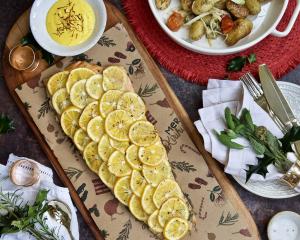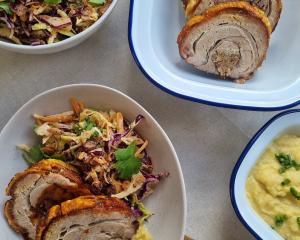One of the most satisfying things you can do in the kitchen is to bake your own bread.
Forget bread-makers, all you need is a kitchen mixer with a dough hook attachment, a large bowl, scales and the time to learn the first few basic steps.
All the breads we make daily at Riverstone Kitchen, we have taught ourselves how to make from scratch, and now it's hard to imagine what our world would be like without fresh ciabatta and sourdough.
The best thing about making bread is, once you've learned the basics, you can start to make any number of variations to reflect your own tastes and personality.
With the cooler weather upon us, we naturally find ourselves inside a little longer and are therefore able to perform the few simple stages that bread requires, and a warm house is also an ideal place for dough to prove.
Here are three recipes that have proven themselves to us over and over again.
Focaccia is ideal for making and eating quickly and the basic dough is perfect for all sorts of variations, even hot-cross buns and hamburger buns.
Ciabatta is one of the easiest breads you'll ever make. Time is the key in allowing those amazing dough bubbles to develop and the result - a beautiful soft loaf that everyone loves.
Sourdough is, for me, the king of breads. For flavour and texture it is second to none and, with a little love, a sourdough starter can almost become part of the family!In the end, food is always about how it eats, and bread is no exception.
It is with some pride that I can honestly say our children ask for "Daddy bread" in preference to shop-bought, pre-sliced, super-white, which is evidence in itself that even little people appreciate homemade.
How often you treat yourself to your own bread is up to you, but I'm a firm believer that every time you do make the effort, the world becomes just that little bit better.
That's what food is all about, so surely it's worth it?
Enough said, get baking!
Sourdough starter
Day 1
1 litre water, lukewarm
500g strong baker's flour (You should be able to buy 'strong bakers flour' in most supermarkets, Edmonds do a good white and wholemeal one. We use "Champion" Epic Bakers flour.)
450g spray-free grapes
Mix water and flour in a very clean bucket with lid. Wrap up grapes in a large square of muslin and tie off ends with string. Push grape bag into the bottom of the flour and water. Cover bucket with a plastic lid and leave for 3 days at room temperature.
Day 4
1 cup strong baker's flour
1 cup water
On the fourth day, feed starter by adding flour and water. Mix well, replace lid and leave to ferment at room temperature for a further 5 days.
Day 9
Remove grape bag from starter, squeezing out as much juice from the bag as possible. For the next 5 days, feed starter 3 times a day. Mix well with your hands each time. The first feed the following day should be no longer than 15 hours from the previous evening's third feed. After 5 days of feeding, your sourdough starter is ready for use.
Repeat feeding schedule each day to maintain starter.
1st feed (morning)
2 cups starter
1 cup water
1¼ cups strong baker's flour
2nd feed (mid-afternoon)
2 cups water
2½ cups strong baker's flour
3rd feed (early evening)
4 cups water
5 cups strong baker's flour

Makes two 450g loaves
Ingredients
1¼ cups sourdough starter (See recipe above)
7 cups strong baker's flour
2¼ cups tepid water (36degC)
½ cup wheat germ
4 tsp sea salt
vegetable oil
Day 1
Place sourdough starter, flour, water and wheat germ into the bowl of an electric mixer and mix with a dough hook attachment on low speed for 5 minutes. Turn off machine and leave dough to rest in the bowl for 15 minutes before adding salt and mixing for a further 5 minutes on low.
Remove dough from mixing bowl and place into a large stainless steel bowl, lightly greased with a little vegetable oil. Cover with plastic wrap and allow to prove in a warm place for 3 hours. Remove dough from bowl, divide in half and "knock back" by picking up each half and slapping dough down on to a bench top 3 to 4 times. Cover dough on bench top with a tea towel and rest for 15 minutes before kneading and shaping each half into a ball. Lightly flour 2 round cane banneton baskets or medium-size bowls and place shaped balls of dough, smooth side down, in baskets. Pinch dough together so that there are no loose seams facing upwards. Put baskets on to an oven tray and place both into a large, clean rubbish bag. Leave to prove at room temperature for 1 hour before placing into the refrigerator overnight.
Day 2
Preheat oven to 220degC. Take bread out of refrigerator and remove rubbish bag. Cover with a tea towel and allow to prove in a warm place for a further 2 hours. Tip bread gently out on to 2 lightly floured baking trays. Using an old-fashioned razor blade, make a large C-shaped cut in the top of the loaves, about 1cm deep. Place into oven and bake for 40 minutes until dark brown. Remove from oven and allow to cool for at least 30 minutes before slicing.
Makes 3 loaves
Day 1 - Biga
500g strong baker's flour
2g dried yeast
275ml cold water
Place all ingredients into a mixing bowl and mix with a dough hook on the slowest speed for 5 minutes. Place biga in a floured bowl and cover with cling wrap. Leave to prove at room temperature overnight.
Day 2- Ciabatta
500g strong baker's flour
4g dried yeast
25g table salt
550ml lukewarm water
Place all ingredients into a mixing bowl and mix with a dough hook on the slowest speed for 1 minute before adding the biga. Mix for a further 15 minutes, still on slow speed, then turn dough into a floured bowl and cover with a tea towel. Allow to prove until double in size. Turn out dough on to a well-floured work surface, removing all the dough from the bowl with a dough scraper. Dust dough with flour and fold into thirds from the outside in. Flour bowl again, return dough, cover with a tea towel and prove for 30 minutes. Turn dough out once more and repeat the folding process. Cover again and prove for another 30 minutes. Repeat the folding and proving process for a third time, then turn dough out and divide into 3 pieces using a floured knife or scraper. Gently lift the dough pieces on to a lined baking tray, cover with a tea towel and prove for a final 30 minutes. Remove tea towel and bake in a 230degC oven for 30 minutes. Ciabatta is ready when the crust is golden brown. Remove from oven and allow to cool.
Makes 12 buns
Ingredients
800g plain flour
550ml lukewarm water
10g dried yeast
10g salt
80ml olive oil
¼ cup milk
2 Tbsp sesame seeds
Method
Preheat oven to 220degC. Place flour, water, yeast, salt and half of the olive oil into the bowl of an electric mixer with dough hook attachment and mix on low speed for 15 minutes. Turn out into another large mixing bowl greased with remaining olive oil. Cover dough with plastic wrap and set aside in a warm place to prove for one hour or until almost doubled in size. Tip dough out on to a clean bench top and divide into 12 equal pieces. Knead and shape each piece of dough into a small ball and place on to a baking tray liberally dusted with extra flour. Brush tops of dough balls with a little milk and sprinkle with sesame seeds. Cover tray with a clean tea towel and allow to prove in a warm place for a further 30min to 45min or until almost doubled in size. Place buns into oven and bake for 20min or until golden brown. Remove from oven and allow to cool for 2-3min before placing on to a wire cake rack. Burger buns are best eaten on the same day.
Tip: Any spare burger buns can be frozen and simply reheated by splashing with a little water and placing into a 180degC oven for 5min to 10min.
• Bevan and Monique Smith own the multi-award-winning restaurant Riverstone Kitchen, on SH1 in North Otago, just south of the Waitaki bridge.











